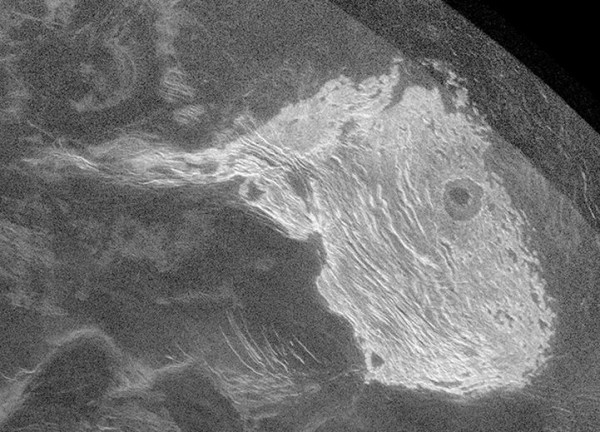New Images Reveal Stunning Details of Venus' Surface
| Arthur Dominic Villasanta | | Mar 11, 2015 07:56 AM EDT |
(Photo : National Science Foundation) Radar image of Maxwell Montes, Venus’ highest mountain range.
Scientists have constructed a remarkably detailed map of the surface of Venus despite the planet's thick clouds of sulfuric acid that shroud most of its surface.
The high-definition images combining the radar-based capabilities of two terrestrial observatories were so sharp they revealed geologic structures like mountains, craters and volcanoes on Venus, which is 38 million kilometers from Earth at its closest and 260 million km at its farthest.
Like Us on Facebook
Earth's "sister planet" has the densest atmosphere among the solar system's four terrestrial planets in the habitable zone. Venus' atmosphere consists of 96 percent carbon dioxide. It's also choked by clouds of shiny sulfuric acid that make the taking of photographs of its surface virtually impossible.
Scientists, however, combined the radar-based capabilities of two observatories to form incredibly detailed images of the Venusian surface.
They used the transmission abilities of the National Science Foundation's Arecibo Observatory in Puerto Rico to beam radio waves to Venus. Once reflected off Venus' surface, the radio waves were intercepted by receivers at the NSF's 100 meter Green Bank Telescope in West Virginia.
"It is painstaking to compare radar images to search for evidence of change, but the work is ongoing," said Bruce Campbell, an astronomer at the Smithsonian's National Air and Space Museum.
"In the meantime, combining images from this and an earlier observing period is yielding a wealth of insight about other processes that alter the surface of Venus."
The new radar technique allowed astronomers to monitor changes in Venus' surface, and will enable further investigation of the planet's geologic systems.
©2015 Chinatopix All rights reserved. Do not reproduce without permission
EDITOR'S PICKS
-

Did the Trump administration just announce plans for a trade war with ‘hostile’ China and Russia?
-

US Senate passes Taiwan travel bill slammed by China
-

As Yan Sihong’s family grieves, here are other Chinese students who went missing abroad. Some have never been found
-

Beijing blasts Western critics who ‘smear China’ with the term sharp power
-

China Envoy Seeks to Defuse Tensions With U.S. as a Trade War Brews
-

Singapore's Deputy PM Provides Bitcoin Vote of Confidence Amid China's Blanket Bans
-

China warns investors over risks in overseas virtual currency trading
-

Chinese government most trustworthy: survey
-

Kashima Antlers On Course For Back-To-Back Titles
MOST POPULAR
LATEST NEWS
Zhou Yongkang: China's Former Security Chief Sentenced to Life in Prison

China's former Chief of the Ministry of Public Security, Zhou Yongkang, has been given a life sentence after he was found guilty of abusing his office, bribery and deliberately ... Full Article
TRENDING STORY

China Pork Prices Expected to Stabilize As The Supplies Recover

Elephone P9000 Smartphone is now on Sale on Amazon India

There's a Big Chance Cliffhangers Won't Still Be Resolved When Grey's Anatomy Season 13 Returns

Supreme Court Ruled on Samsung vs Apple Dispute for Patent Infringement

Microsoft Surface Pro 5 Rumors and Release Date: What is the Latest?










